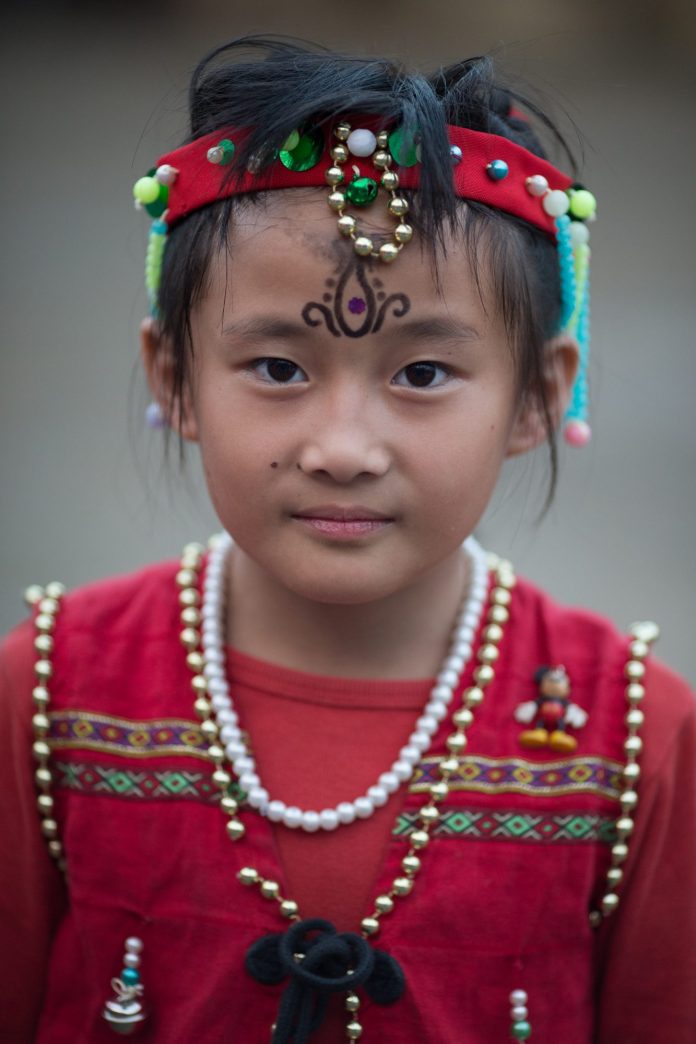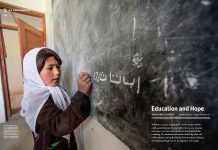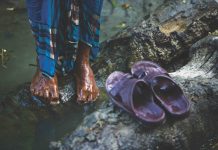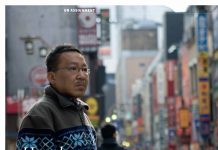
Taiwan negotiates its cultural survival – and revival – in the face of modernisation
Text Nic Barkdull
Photos Paul Ratje
As the sun sets, a vanguard of boys enters the ceremonial grounds, shouldering large V-shaped objects covered in colourful plastic streamers and bells. They bounce up and down to set a beat while seated onlookers look towards the line of approaching Saisiyat tribespeople. As they begin to flood into the grounds, rocking their bodies as they step in time with the jangling bells, their haunting singing – energetic, but mournful – rises in volume.

The line of people is connected by intertwined arms – each hand crosses the body of the person adjacent to them to grasp the hand of the next person. They are dressed in the traditional blood-red clothing of the Saisiyat tribe with matching headbands. The end of the line is brought up by men and women whose backs are adorned with mirrors and rows of metal tubes, which clink together as they sway.
As they circle the ceremonial grounds, the repetitive dance becomes hypnotic. This is part of the Taiwanese Saisiyat tribe’s performance of the rare Pasta’ay ritual, which commemorates the Ta’ay, a mythical pygmy race of “short black people” that died at the hands of the Saisiyat hundreds of years ago. It is performed every two years, but 2016 marked the “grand ceremony”, which happens only once every decade.
The ritual can last up to a month, but there are only a few nights where outsiders are invited in to observe and join their dance of remembrance. Joined hand-in-hand, the dancers form alternating concentric circles which unexpectedly stop, speed up, and change direction from sundown to sunrise. Joining in the ritual, one can experience undeniably powerful camaraderie, which lasts for 12 continuous hours.
The ancient ceremony is not devoid of modern influence: Aboriginal youth donning traditional clothing and joining in the ancient dance flash branded shoes and the newest smartphones, contemporary Taiwanese street food is sold alongside the traditional indigenous wine, and plastic streamers, feathers and metal chimes intermingle where Japanese bullet casings and bamboo were once worn instead.
This inclusion of the modern does not seem sacrilegious – it appears to be a necessary adaptation in the face of cultural erasure. Taiwan was previously colonised by the Dutch, various Chinese groups, and the Japanese, and several indigenous groups disappeared as a result of subsequent violence, displacement, cultural assimilation, and capitalist pressures. Some have survived. Pasta’ay, while remaining true to its original form, is evolving, displaying the Saisiyat’s cultural survival, and revival.
Pasta’ay is also a form of apology to the now extinct Ta’ay – but it is not only the Saisiyat doing the apologising. Remembering the cultural marginalisation of indigenous groups has recently re-surfaced as a priority of the Taiwanese government. In August 2016, Taiwanese president Tsai Ying-wen made an unprecedented speech in August 2016 in which she apologised to Taiwan’s aboriginal people for “four centuries of pain and mistreatment”. Significantly, her speech touched on the importance of remembrance. She apologised for the way history has been written to ignore Taiwan’s indigenous people, and for the banning of indigenous languages by the Japanese and early Taiwanese government. She made an oath to rectify these injustices.
Speaking about truth and reconciliation, she said: “In the Atayal language, truth is called balay, and reconciliation is called sbalay, so you simply add an ‘S’ sound to balay. Truth and reconciliation are, in fact, two related concepts. In other words, only by facing the truth sincerely can reconciliation be attained.”
The event was accompanied by solidarity from indigenous representatives, but was also met with protest at what was seen as a meagre attempt to appease indigenous groups. Some expressed cynicism for both sides: “The president doesn’t need to apologise to us,” said 35-year-old Yeqin (葉芩) outside her home in the half-Saisiyat, half-Atayal village of Qingquan, near the site of Pasta’ay. “Why did she tell aborigines to sit out in the sun and line up in hot clothes for an apology? It isn’t right. Saying sorry to us has
no use. The damage is already done.”
Yeqin says that she still encounters negative stereotypes about aboriginal groups – like whether aborigines drink all the time. The problem, in Yeqin’s view, runs much deeper than a word of apology from the president. Yeqin and her 60-year-old mother-in-law, Jinying (金英) – who also goes by the Atayal name, Jiwas – do most of the talking as Yeqin’s husband and their family gather in the yard to shell “tree beans”, which is part of an annual tradition. The black beans sell for a high price and are a “must-have” dish over the festive season.

Compared to her daughter-in-law, Jiwas has a positive view of the current government. She talks about the hard days of her youth, when she had to wake in the early hours and walk for hours to farm vegetables. Now, she is impressed with the infrastructure in the area. The roads that wind through the steep mountains to Qingquan regularly experience landslides, but the government’s repairs are quick and efficient, she feels.
Jiwas does not miss the old days, saying that children now have the opportunity to get educated. During her childhood, they were punished for speaking their native language. Still, she laments the fact that it’s difficult for today’s youth to learn their mother tongue. Her daughter-in-law agrees that the Atayal language and culture are important, but she has to rely on speaking Chinese because it is central to earning a living.
Selling out – or getting by?
Money seems to be at the heart of controversy for the small village.
Tourism is a strong influence shaping modern Qingquan, since it is near
the location of Pasta’ay, as well as an aboriginal street market, hot springs, and the Zhang Xueliang (張學良) residence, which has been converted into a museum. Money is being poured into the latter, partially due to increasing tourism from mainland China.
This growth in tourism in the area alarms some local residents, however. In mid-November in 2016, white banners were strung all around the town in protest of aboriginal culture being “sold out” in favour of commercialisation.
“Don’t pay attention to that,” says Bidai (比黛), a 52-year-old woman who sells xiaomijiu (a sweet indigenous wine). She explains that some members of the community are dissatisfied with the construction going on to make
the small village more welcoming for tourists. But it is clear that Bidai’s business benefits from the development, as her livelihood is largely dependent on tourism. Producing and selling xiaomijiu isn’t a family business, but a product of the recent tourist interest in the area, and its indigenous wine. Referring back to her childhood, Bidai says: “Back then, nobody bought xiaomijiu.”

Apology through remembrance
Today, as Bidai sees it, the word is out that “traditional aboriginal wine is a delicious drink”. Xiaomijiu is easily the most popular product sold at Pasta’ay, as it’s hugely popular among local tourists from Taiwan, mainland China, and even with the “foreigners” – the Taiwanese label for Caucasians. Like Jiwas, Bidai prefers the modern world. “We were so poor we didn’t have shoes,” she recalls of her youth. “It was so cold in the winter. My mom got bark from trees and made shoes for herself.”
Damages and Compromise
On the other hand, there are indigenous people who have not benefitted from modernisation, facing a growing economic gap and disparities in access to health services and political participation. There are also more direct violations, such as the dumping of nuclear waste in the Yami tribe’s territory on Orchid Island. These problems were mentioned in Tsai Ying-wen’s public apology, but how to move forward remains unclear.

to form alternating concentric circles, which unexpectedly stop, speed up, and change direction, surrounded by onlookers in Hsinchu County
It’s a paradoxical situation: In pursuing development, tourism improves financial gain and education in communities, but at the cost of losing aspects of indigenous culture. Bidai has reached a compromise, proudly sharing her culture with outsiders, despite dissent that vilifies her as “selling out”. But these grievances seem irrelevant to her: “We don’t expect much. We’re easily satisfied. We just need three meals a day – a full stomach. We don’t talk badly about anyone. And aboriginal children are very kind-hearted.”
Pasta’ay represents a similar compromise in the face of this predicament – the push and pull between loss, remembrance, and adaptation. In remembering and honouring a bygone culture, the ritual simultaneously preserves and celebrates that which has survived, and endures.
For more stories and photographs from this issue, see Asian Geographic Issue 124, 2017










